Intelligent Traffic Management System Market Size & Overview:

Get More Information on Intelligent Traffic Management System Market - Request Sample Report
The Intelligent Traffic Management System Market Size was valued at USD 11.25 billion in 2023 and is expected to reach USD 36.5 billion by 2032 and grow at a CAGR of 14% over the forecast period 2024-2032.
An intelligent traffic management system is a sophisticated application that attempts to deliver cutting-edge traffic management and transportation services. It allows users to be more informed, efficient, and coordinated, as well as make more intelligent use of transportation networks. It enhances goods and people transportation, decreases traffic congestion, and improves safety. It also complies with transportation policy objectives, such as priority measures for public transportation. Communication and information technologies are used in this system to control traffic in the areas of road infrastructure, users, road transportation, automobiles, and traffic management. In crises such as fires, natural catastrophes, terrorist attacks, and riots, this system is critical in providing an expedient and effective means of the mass evacuation of people.
Road safety, traffic flow, and mobility are all ensured by an intelligent traffic management system. It also delivers real-time information for fast analysis and response to emergencies. Various countries are working to improve their traffic management infrastructure in order to alleviate traffic congestion. The use of telematics services in vehicles can improve security and safety dramatically. Telematics tracking systems are commonly used in automobiles and allow for remote access and activation of vehicles via radio frequency identification.
MARKET DYNAMICS:
KEY DRIVERS:
-
Favorable government initiatives aimed at improving traffic management.
-
Globally, there is a greater need to alleviate traffic congestion, as well as the rapid growth of smart cities.
-
Governments are likely to focus on constructing infrastructure that supports smart city transportation networks.
RESTRAINTS:
-
The high cost of installation.
-
The market's expansion would be hampered by a scarcity of skilled individuals.
OPPORTUNITIES:
-
Several countries are implementing ITMS to improve road safety & transportation system operating performance.
-
Municipalities are establishing an ITMS to reduce on-road traffic congestion.
-
Developed countries are substantially investing in various ITMS-related projects.
CHALLENGES:
-
Carbon dioxide emissions in huge quantities.
-
For an urban planner, safety issues are expected to have an impact on the market expansion.
IMPACT OF COVID-19:
With the global proliferation of the novel coronavirus COVID-19, automakers are adopting drastic measures such as plant closures to limit the virus's spread. The pandemic COVID-19 has had a significant impact on the market in terms of new sales and installations. Due to component supply difficulties, a number of prominent systems manufacturers have temporarily halted operations. The market demand for intelligent traffic management systems was knowingly influenced by a drop in global vehicle manufacturing due to factory closures. Major automakers' unwavering attempts to develop more modern modes of transportation kept demand afloat. The breakout of the COVID-19 pandemic has had an equal impact on companies, customers, and suppliers, and the worldwide intelligence traffic management system market is projected to face similar issues in 2021.
Market, By Solution:
Based on the solution segment, the global market has been divided into Traffic Monitoring systems, Traffic Enforcement cameras, Traffic Signal Control systems, Intelligent Driver Information systems, Integrated Corridor Management, and Others. One of the most important transportation infrastructures is a traffic monitoring system, and transportation authorities spend a lot of money collecting and analyzing traffic data. A traffic signal control system is an electronic device that controls the sequence of lights at intersections.
MARKET SEGMENTATION:
By Solution:
-
Traffic Monitoring System
-
Traffic Enforcement Camera
-
Traffic Signal Control System
-
Intelligent Driver Information System
-
Integrated Corridor Management
-
Others
REGIONAL ANALYSIS:
North America: Due to developments in communication technologies that have aided the revolution of the transportation network, North America accounted for the second-largest share of the worldwide market. With rising demand for advanced technologies and the expansion of transportation networks, Asia Pacific is undergoing rapid transformation and is predicted to grow at a high CAGR over the projection period. Governments are working on enhancing overall physical infrastructure to alleviate the strain of declining land carrying capacity. Transportation is an important component of physical infrastructure. Demand for intelligent traffic management systems is likely to rise dramatically in nations like China, Japan, South Korea, and India, which are expected to drive the industry forward. Furthermore, the market is likely to increase as a result of measures done by government authorities in the region.

Get Customized Report as per Your Business Requirement - Request For Customized Report
REGIONAL COVERAGE:
North America
-
US
-
Canada
-
Mexico
Europe
-
Eastern Europe
-
Poland
-
Romania
-
Hungary
-
Turkey
-
Rest of Eastern Europe
-
-
Western Europe
-
Germany
-
France
-
UK
-
Italy
-
Spain
-
Netherlands
-
Switzerland
-
Austria
-
Rest of Western Europe
-
Asia Pacific
-
China
-
India
-
Japan
-
South Korea
-
Vietnam
-
Singapore
-
Australia
-
Rest of Asia Pacific
Middle East & Africa
-
Middle East
-
UAE
-
Egypt
-
Saudi Arabia
-
Qatar
-
Rest of Middle East
-
-
Africa
-
Nigeria
-
South Africa
-
Rest of Africa
-
Latin America
-
Brazil
-
Argentina
-
Colombia
-
Rest of Latin America
KEY PLAYERS:
Siemens AG (Germany), TomTom International BV, IBM Corporation (U.S.), Thales Group (France), SNC-Lavalin Group (Atkins); Q-Free ASA (Norway), Cubic Corporation, General Electric Company, Kapsch TrafficCom, (China), Transcore, are some of the affluent competitors with significant market share in the Intelligent Traffic Management System Market.
| Report Attributes | Details |
|---|---|
| Market Size in 2023 | US$ 11.25 Billion |
| Market Size by 2032 | US$ 36.5 Billion |
| CAGR | CAGR of 14% From 2024 to 2032 |
| Base Year | 2023 |
| Forecast Period | 2024-2032 |
| Historical Data | 2020-2022 |
| Report Scope & Coverage | Market Size, Segments Analysis, Competitive Landscape, Regional Analysis, DROC & SWOT Analysis, Forecast Outlook |
| Key Segments | • by Solution (Traffic Monitoring System, Traffic Enforcement Camera, Traffic Signal Control System, Intelligent Driver Information System, Integrated Corridor Management, Others) |
| Regional Analysis/Coverage | North America (US, Canada, Mexico), Europe (Eastern Europe [Poland, Romania, Hungary, Turkey, Rest of Eastern Europe] Western Europe] Germany, France, UK, Italy, Spain, Netherlands, Switzerland, Austria, Rest of Western Europe]), Asia Pacific (China, India, Japan, South Korea, Vietnam, Singapore, Australia, Rest of Asia Pacific), Middle East & Africa (Middle East [UAE, Egypt, Saudi Arabia, Qatar, Rest of Middle East], Africa [Nigeria, South Africa, Rest of Africa], Latin America (Brazil, Argentina, Colombia, Rest of Latin America) |
| Company Profiles | Siemens AG (Germany), TomTom International BV, IBM Corporation (U.S.), Thales Group (France), SNC-Lavalin Group (Atkins); Q-Free ASA (Norway), Cubic Corporation, General Electric Company, Kapsch TrafficCom, (China), Transcore |
| Key Drivers | •Favorable government initiatives aimed at improving traffic management. •Globally, there is a greater need to alleviate traffic congestion, as well as the rapid growth of smart cities. |
| RESTRAINTS | •The high cost of installation. •The market's expansion would be hampered by a scarcity of skilled individuals. |

